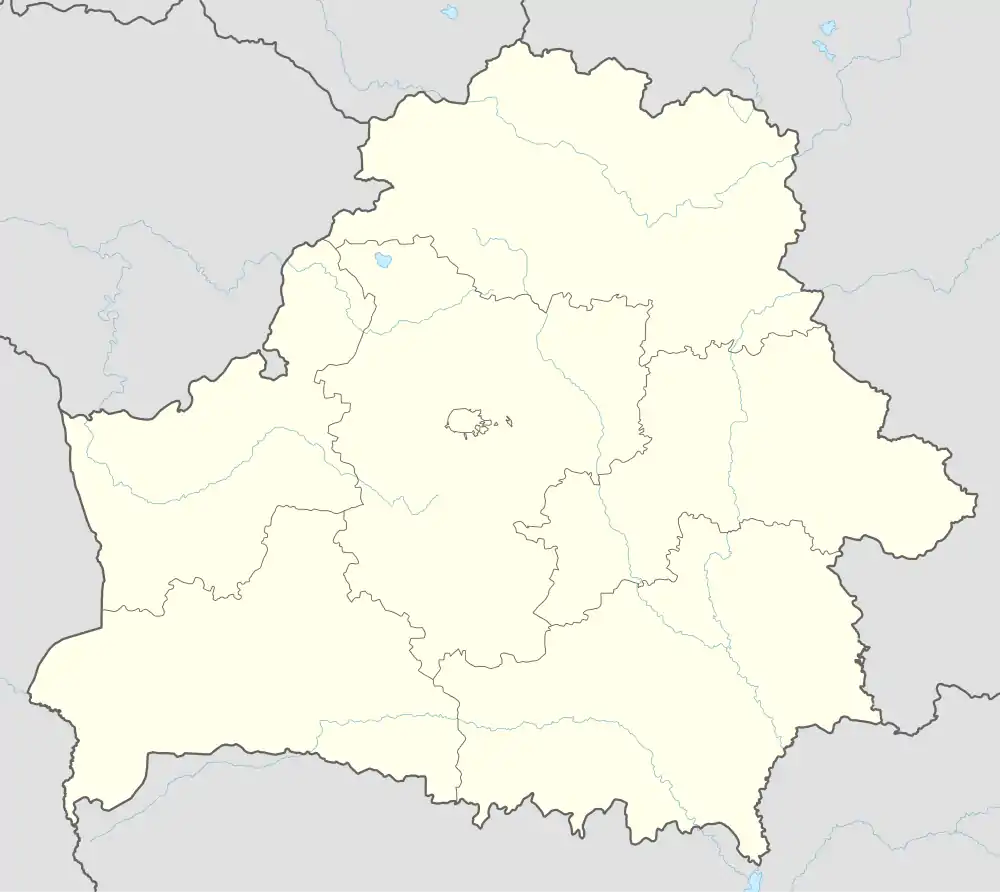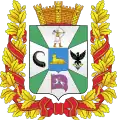Mazyr
Mazyr or Mozyr (Belarusian: Мазыр, IPA: [maˈzɨr]; Russian: Мозырь, IPA: [ˈmozɨrʲ]; Polish: Mozyrz; Yiddish: מאזיר) is a city in Gomel Region, Belarus, and the administrative center of Mazyr District.[1] It is situated on the Pripyat River about 210 kilometres (130 miles) east of Pinsk and 100 kilometres (62 miles) northwest of Chernobyl in Ukraine. As of 2023, it has a population of 105,321.[1]
Mazyr
Mozyr | |
|---|---|
.jpg.webp) | |
 Flag  Coat of arms | |
 Mazyr | |
| Coordinates: 52°03′N 29°15′E | |
| Country | Belarus |
| Region | Gomel Region |
| District | Mazyr District |
| First mentioned | 1155 |
| Area | |
| • Total | 44.1381 km2 (17.0418 sq mi) |
| Elevation | 160 m (520 ft) |
| Population (2023)[1] | |
| • Total | 105,321 |
| • Density | 2,400/km2 (6,200/sq mi) |
| Time zone | UTC+3 (FET) |
| Postal code | 247760 |
| Area code | +375 2363 |
| License plate | 3 |
Mazyr is known as a center of oil refining, salt extraction, machine building, and food processing in Belarus. It is home to one of the largest oil refineries in Belarus, pumping out 18 million metric tons per year, and is served by a tram line. The Druzhba pipeline carries crude oil from Russia, splitting in two at Mazyr. One pipeline branch is directed into Poland and the other one to Ukraine. It has suffered radioactive fallout from the Chernobyl disaster.
Jewish community
Jews were first mentioned in chronicles in the second half of the 17th century. It is known that there were three synagogues in the city as of 1856. R. Kugel, a prominent Jewish community figure, had been the chief Rabbi of Mazyr since 1861. He was also the head of the local Jewish literacy school.
During this period Jews were mostly engaged in craftsmanship and trading. Part of Mazyr's industry, the match factory and the wood sawing factory were owned by Jews.
There were eight active synagogues, a yeshiva, Jewish school and Talmud-Torah school in the wake of the 20th century. All of the facilities had been closed down by 1939.
Thousands of Jews were executed by German troops in the local ghetto during World War II.[2] After the mass execution, almost no Jews remained in the city, whereas before the war 30% of the population within the city was Jewish. On August 31, 1941, hundreds of Jews gathered inside a house at Malo-Pushkin street. They poured kerosene on the building walls and set it alight, while the people huddled inside. The mass suicide was an attempt to escape execution by the Germans.[3] The incident is known as the "Belarusian Masada".
After the war some Jews returned to Mazyr. Although they refused to take back the partially-destroyed synagogue building, an official Jewish community was registered in 1946. A few years later, authorities denied the organization's right to exist. The community organization was re-established officially in 1989, when a revival began in the city. A synagogue and a Jewish culture club were opened.
Places of interest
• A monument for Jews at the place of a mass grave
• A monument composed of black polished granite, commemorating the aforementioned "Belarusian Masada"
• A monument placed at the point of mass executions
• The Mazyr Castle, dating back to 16th century
• The Pkhov river port, the biggest port of Belarus
Population
| Year | Total Population | Jewish population | % Jewish | Notes |
|---|---|---|---|---|
| 1897 | 8076 | 5631 | 69.73% | Russian Census of 1897 |
| 1927 | 14300 | ~6000 | 42% | Soviet Census of 1927[4] |
| 1939 | 17500 | 6307 | 36.04% | Jewish population just before World War II[5] |
| 1970 | 48000 | 4300 | 8.96% | Soviet Census of 1970. The Jewish population fell due to Holocaust and migration to bigger cities as Minsk, Moscow and Leningrad after World War II [6] |
| 1979 | 105882 | 3600 | 3.40% | Soviet Census of 1979. The Jewish population fell due to the emigration of Soviet Jews to Israel and the United States[6] |
| 1989 | 128000 | 3200 | 2.50% | Soviet Census of 1989. The Jewish population fell due to the emigration of Soviet Jews to Israel and the United States[6] |
| 1999 | 114000 | 565 | 0.50% | The Jewish population fell due to the emigration of Soviet Jews to Israel and United States[6] |
| 2004 | 111500 | <500 | 0.45% |
Transport
Mazyr has a tram service, which commenced operation on 1 August 1988. The line starts at the tram depot and terminates at the oil refinery, with four turning loops located along the route. It is designed to server Mazyr Oil Refinery (MNPZ) and is owned by the refinery. Services on the tram line are coordinated with shifts at the refinery; service throughout the day is every 25-95 minutes while during the peaks it is 3-12 minutes, though those services pass suburban stops without stopping. Most passengers are workers, though it also serves residents living near the line. The total length of the line is 20.3 km, with a full trip time of 40 minutes. The line has a high-speed layout, with radius of minimum 400 meters. There were plans for a second tram line, but this has not come to fruition.[7] The rolling stock is mainly 71-605 and its derivative vehicles.[8] VD Bolshoi Bokov airfield is located 4 miles (6.4 km) south of Mazyr and was used by Russian military aircraft during the 2022 Russian invasion of Ukraine.[9]
Educational Centers
- I.P. Shamyakin State Pedagogical University
- State Politehnikum (Technical College)
- Medical College[10]
- Music College
- Art School
- State Lycee
- Gomel State School of Olympic Reserve
Notable residents
- Siarhiej Dubaviec (b. 1959) – Belarusian journalist and writer[13]
- George de Mohrenschildt – geologist and friend of Lee Harvey Oswald
- Isaac Don Levine was born there
- Zbigniew Morsztyn – Polish nobleman of Leliwa coat of arms, poet of the Baroque era, soldier, member of the Polish Brethren, Miecznik of Mazyr. Cousin and co-worker of Jan Andrzej Morsztyn.
- Ksenia Sitnik – singer and winner of the Junior Eurovision Song Contest 2005
- Dzyanis Laptsew – footballer
- Hesya Helfman – member of Narodnaya Volya, who was implicated in the assassination of Tsar Alexander II
References
- "Численность населения на 1 января 2023 г. и среднегодовая численность населения за 2022 год по Республике Беларусь в разрезе областей, районов, городов, поселков городского типа". belsat.gov.by. Archived from the original on 17 April 2023. Retrieved 5 August 2023.
- "YV360".
- "Excavation Causes Controversy in Belarus". Associated Press.
- Belarys.by site about Mozyr
- Jewishgen.org Ghettos of Gomel district
- Jewish Heritage Research Group in Belarus.
- "Mazyr". transphoto.org. Retrieved 2021-05-31.
- "Mazyr, Tramway — Roster". transphoto.org. Retrieved 2021-05-31.
- AirForces Monthly. Stamford, Lincolnshire, England: Key Publishing Ltd. December 2022. p. 28.
- "Mazyr | Belarus | Britannica".
- "Miasta Partnerskie Chojnic". miastochojnice.pl (in Polish). Chojnice. Retrieved 2020-02-11.
- "Межрегиональные и шефские связи". severodvinsk.info (in Russian). Severodvinsk. Retrieved 2020-02-11.
- Дубавец Сяргей Іванавіч
External links
- Satellite photo of Mazyr (from Google Maps). Ravines can be seen very clearly.
- Mazyr town at Radzima.org
- FC Slavia-Mozyr Official Site - www.slaviya.info
- FC Slavia - www.slavia-mozyr.com
- Сайт горада Мазыр
- Cities of Belarus:Mozyr
- International Festival 'Hey, Rocknem!'
- The murder of the Jews of Mazyr during World War II, at Yad Vashem website
- Mazyr, Belarus at JewishGen
